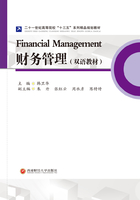
5.1 Introduction to Bond
A bond(also called debt security or debentures)is a debt contract, under which the issuer owes the holders a debt and, depending on the terms of the bond, is obliged to pay them interest and/or to repay the principal at a later date. The pattern of the cash payment to bondholder varies ac
cording to the different types of bond.
Very often the bond is negotiable, that is, the ownership of the instrument can be transferred in the secondary market. This means that once the transfer agents at the bank medallion stamp the bond, it is highly liquid on the second market.
As a form of loan, bonds provide the borrower with external funds to finance long-term investments, or, in the case of government bonds, to finance current expenditure.
5.1.1 Bond Terminology
票面价值
The followings are some terminology relate to bond.
Par value(principal/face value):
Bonds are issue with a par value or face value(or principal)and are traded based on their interest rates. The face value is used to compute the interest payments.
利息
Coupons(interest):
In addition to the face value, some bonds also promise additional payments called coupons.
到期日
Maturity date:
The date when the issuer of the bond makes the last payment is called the maturity date. The bond is said to expire or mature on the date of its final payment.
到期收益率
Yield to maturity(YTM):
YTM is the interest rate required by the market on a bond, is defined as the discount rate that sets the present value of the promised bond payments equal to its the current market price, and is the same as IRR(discounted future bond cash-flow equals the price of the bond)
A few notes about bonds:
·Bond is always quoted in $100 nominal units; we always use $100 nominal values as the basis when doing calculation.
·Bonds can be priced at a premium, discount, or at par.
·Coupon interest rate is NOT the same as the YTM.
Illustration 5.1
In March 2013, Baoke Co. has issued $6 million 10-year bond at par with coupon rate of 5%, coupon has been paid annually.
Supposed an investor purchased the bond at price of $102 in 2017, he would be expecting to receive fixed coupon of $100×5%=$5 annually for the following 6 years till 2023, as well as the par value of $100 at the time of ma turity, says March 2023.
5.1.2 Types of Bonds
不可赎回债券
无息债券
有息债券
We will explore more details of various bonds based on different criteria on later chapter, now we shall look at the types of bonds according to its cash flows pattern. There are the followings:
·irredeemable bond;
·zero-coupon bond;
·coupon bond.
(1)Irredeemable bond
Although almost bonds will be redeemed at maturity date, historically there have a British government bond(gilts)in the form of perpetual bond, named consol , redeemable at the option of government. The first consols were issued by Bank of England in 1751. With the final redemption in July 2015, they have been now fully redeemed.
, redeemable at the option of government. The first consols were issued by Bank of England in 1751. With the final redemption in July 2015, they have been now fully redeemed.
(2)Zero-coupon bond
A bond makes no periodic interest payments but instead is sold at discount from its face value. That is why this bond is also called discount bond. An investor is compensated for the time value of money by purchasing the bond at a discount to its face value and redeemed on its maturity date.
Illustration 5.2
Examples of new issue China treasury bond in early 2017(Figure 5.1).

Figure 5.1
Source:bond. hexun. com
Example 5.1
An one-year, risk-free, zero-coupon bond with a $100000 face value has an initial price of $96618.36. What is the return of the bond if investing on this bond and held to maturity?
Solution
The return of the bond is known as yield to maturity,

Investing in the bond then holding it to maturity is like earning 3.5% interest on the initial investment($96618.36).
The yield to maturity can be viewed as the bond's promised rate of return, which is the return that investors will receive if all the promised payments are made. Hence, it equals the expected rate of return to great extent, changing whenever interest rates in the economy change, and that is almost daily between the purchase date and the maturity date.
(3)Coupon bond
Coupon bond is the most common type of bond with cash flows consisting of a coupon(interest)payment until maturity as well as repayment of the par value of the bond at maturity. Coupon(interest)is usually payable at fixed interval.
Note that the frequency of coupon payment varies, could be paid annually, or semi-annually according to the terms of the bond. Generally, in the US, the UK, Canada and Japan, most bonds make coupon payments semi-annually.
Illustration 5.3
In March 2013, Wanke Ltd. has issued $10 million 5-year bond at par with coupon rate of 5%, coupon has been paid semi-annually.
Supposed an investor purchased the bond at price of $102 in 2016, he would be expecting to receive coupon of $100×5%÷2=$2.5 every half a year, as well as the par value of $100 at the time of maturity, says March 2018.